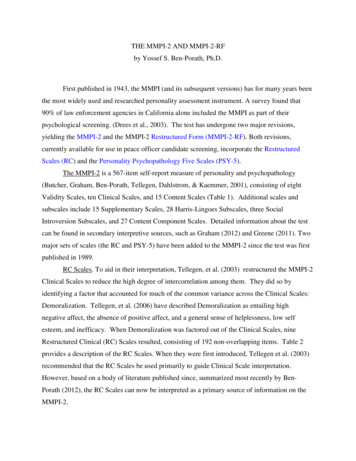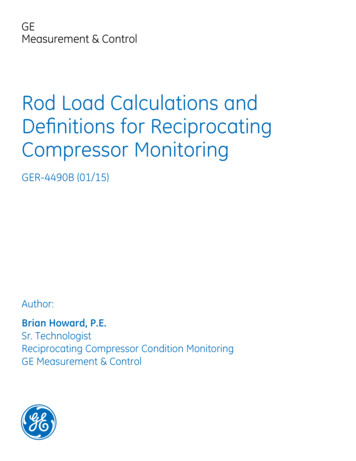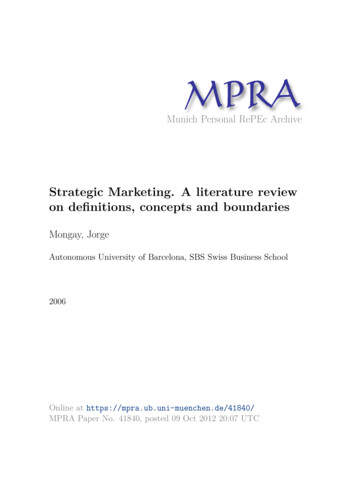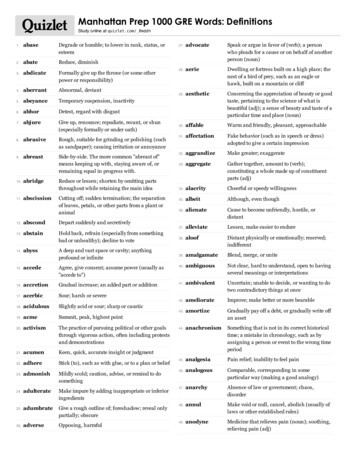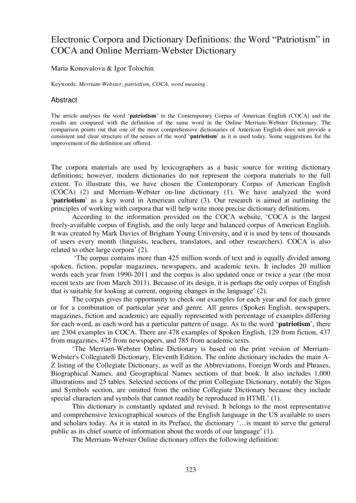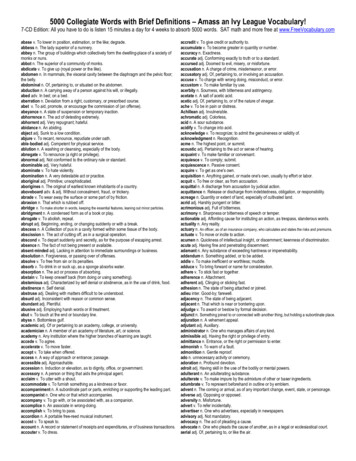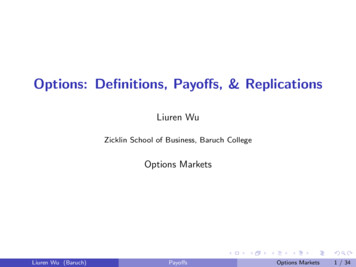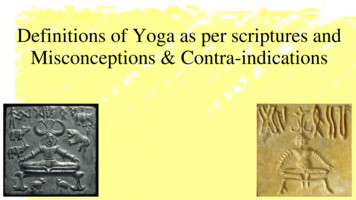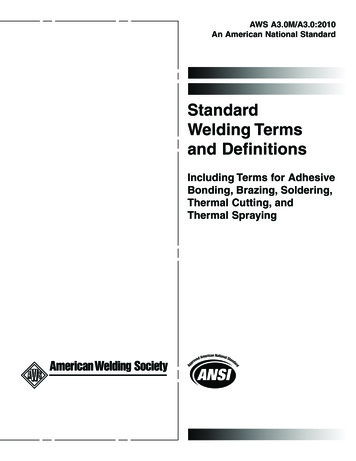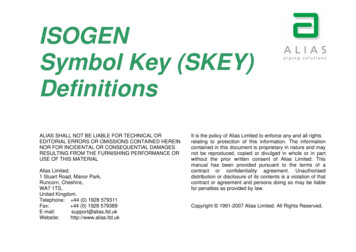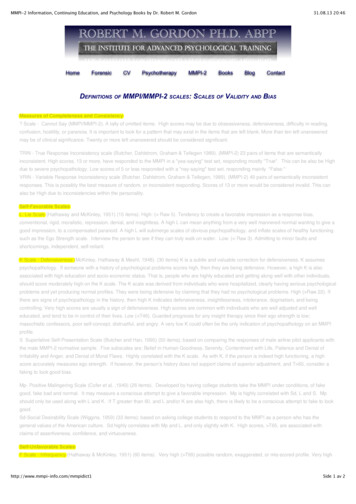
Transcription
MMPI-2 Information, Continuing Education, and Psychology Books by Dr. Robert M. GordonHomeForensicCVPsychotherapyMMPI-231.08.13 20:46BooksBlogContactDEFINITIONS OF MMPI/MMPI-2 SCALES: SCALES OF VALIDITY AND BIASMeasures of Completeness and Consistency? Scale - Cannot Say (MMPI/MMPI-2). A tally of omitted items. High scores may be due to obsessiveness, defensiveness, difficulty in reading,confusion, hostility, or paranoia. It is important to look for a pattern that may exist in the items that are left blank. More than ten left unansweredmay be of clinical significance. Twenty or more left unanswered should be considered significant.TRIN - True Response Inconsistency scale (Butcher, Dahlstrom, Graham & Tellegen 1989). (MMPI-2) 23 pairs of items that are semanticallyinconsistent. High scores, 13 or more, have responded to the MMPI in a "yea-saying" test set, responding mostly "True". This can be also be Highdue to severe psychopathology. Low scores of 5 or less responded with a "nay-saying" test set, responding mainly "False."VRIN - Variable Response Inconsistency scale (Butcher, Dahlstrom, Graham & Tellegen, 1989). (MMPI-2) 49 pairs of semantically inconsistentresponses. This is possibly the best measure of random, or inconsistent responding. Scores of 13 or more would be considered invalid. This canalso be High due to inconsistencies within the personality.Self-Favorable ScalesL Lie Scale (Hathaway and McKinley, 1951) (15 items). High: ( Raw 5). Tendency to create a favorable impression as a response bias,conventional, rigid, moralistic, repression, denial, and insightless. A high L can mean anything from a very well mannered normal wanting to give agood impression, to a compensated paranoid. A high L will submerge scales of obvious psychopathology, and inflate scales of healthy functioningsuch as the Ego Strength scale. Interview the person to see if they can truly walk on water. Low: ( Raw 3). Admitting to minor faults andshortcomings, independent, self-reliant.K Scale - Defensiveness (McKinley, Hathaway & Meehl, 1948). (30 items) K is a subtle and valuable correction for defensiveness. K assumespsychopathology. If someone with a history of psychological problems scores high, then they are being defensive. However, a high K is alsoassociated with high education and socio-economic status. That is, people who are highly educated and getting along well with other individuals,should score moderately high on the K scale. The K scale was derived from individuals who were hospitalized, clearly having serious psychologicalproblems and yet producing normal profiles. They were being defensive by claiming that they had no psychological problems. High ( Raw 22). Ifthere are signs of psychopathology in the history, then high K indicates defensiveness, insightlessness, intolerance, dogmatism, and beingcontrolling. Very high scores are usually a sign of defensiveness. High scores are common with individuals who are well adjusted and welleducated, and tend to be in control of their lives. Low ( T46). Guarded prognosis for any insight therapy since their ego strength is low;masochistic confessors, poor self-concept, distrustful, and angry. A very low K could often be the only indication of psychopathology on an MMPIprofile.S Superlative Self-Presentation Scale (Butcher and Han, 1995) (50 items); based on comparing the responses of male airline pilot applicants withthe male MMPI-2 normative sample. Five subscales are; Belief in Human Goodness, Serenity, Contentment with Life, Patience and Denial ofIrritability and Anger, and Denial of Moral Flaws. Highly correlated with the K scale. As with K, if the person is indeed high functioning, a highscore accurately measures ego strength. If however, the person’s history does not support claims of superior adjustment, and T 65, consider afaking to look good bias.Mp- Positive Malingering Scale (Cofer et al. ,1949) (26 items). Developed by having college students take the MMPI under conditions, of fakegood, fake bad and normal. It may measure a conscious attempt to give a favorable impression. Mp is highly correlated with Sd, L and S. Mpshould only be used along with L and K. If T greater than 60, and L and/or K are also high, there is likely to be a conscious attempt to fake to lookgood.Sd-Social Desirability Scale (Wiggins, 1959) (33 items); based on asking college students to respond to the MMPI as a person who has thegeneral values of the American culture. Sd highly correlates with Mp and L, and only slightly with K. High scores, T65, are associated withclaims of assertiveness, confidence, and virtuousness.Self-Unfavorable ScalesF Scale - Infrequency (Hathaway & McKinley, 1951) (60 items). Very high ( T99) possible random, exaggerated, or mis-scored profile. Very highhttp://www.mmpi-info.com/mmpidict1Side 1 av 2
MMPI-2 Information, Continuing Education, and Psychology Books by Dr. Robert M. Gordon31.08.13 20:46scores (T 90) commonly found with psychotic patients. High scores ( T70), best measure of overall psychopathology, resentment, acting out,moodiness. Mostly elevations in the F scale are due to psychopathology; high item overlap with scale 8. Low scores (T 45), possible fake goodprofile.Fb - Back F scale (Butcher, Dahlstrom, Grahm & Tellegen, 1989). (MMPI-2) 40 items found after item 280. Developed like the F scale, it is madeup of items that are endorsed less than 10% of the time by normals (but frequently by disturbed individuals). If Fb is above T99, and F is not high,then the individual may have randomly responded to the latter part of the test. This is more likely than the other possible interpretation, namely thatthe testee decompensated toward the end of the test from having taken such a long self-report.Ds Dissimulation Scale (Gough,1954); (58 items); developed on true neurotics verses normals faking neurosis, Ds measures more exaggerationof neurotic symptoms, whereas F and Fb assesses more exaggeration of psychotic or severe symptoms. Scores greater than T65 suggest someexaggeration, and scores greater than T98 are most likely to be exaggerated.F(p)- Infrequency-Psychopathology Scale (Aribisi and Ben-Porath,1995a, 1995b); (27 items); the F scale was developed on normals whoresponded to items less than 10% of the time. The F(p) scale was constructed of items endorsed by 20% or less by two separate groups ofpsychiatric patients vs. the MMPI-2 sample. The F(p) is better than F or Fb in detecting feigning serious psychopathology. Scores between T71and T113 may be exaggerated, unless the psychopathology is obviously severe; scores greater than T113 suggest exaggeration.Go to Basic ScalesContact Information Privacy Policy Site Map1983-2011 Robert M. Gordon, Ph.D. ABPP. All Rights Reserved. Material may be copied for non-commercial personal use only.http://www.mmpi-info.com/mmpidict1Side 2 av 2
MMPI-2 Information, Continuing Education, and Psychology Books by Dr. Robert M. GordonHomeForensicCVPsychotherapyMMPI-231.08.13 20:40BooksBlogContactDEFINITIONS OF MMPI/MMPI-2: BASIC SCALES AND SUB-SCALES - 1 - 5Consider "High" to be T65 or more on the MMPI-2. The higher a scale, the more the more pathological descriptors apply. Use the more benigndescriptors with moderately high scores. Consider "low" to be about T40 and below.The correlations I refer to are based on my study of 200patients, forensic and selection clients.1 (Hs) Hypochondriasis - Hathaway & McKinley (1940). (32 items). High: Preoccupation about one's health, a tendency to exaggerate physicalsymptoms, demanding, whiny, immature, little psychological mindedness, poor prognosis for any kind of treatment. As with any personality scale, itdoes not rule out organic disease. But nor does disease rule out the psychological need to exaggerate and complain- which scale 1 measures verywell. Warning: Do not ask a High 1 how he or she is feeling unless you have nothing better to do. Low: Healthy, insightful, optimistic. Correlatesmainly with Hysteria (3) .79.2 (D) Depression - Hathaway & McKinley (1942). (57 items) Very High: Often associated with Major Depression. High: Clinical depression,pessimism, guilt feelings. Low: Absence of depression, cheerful, competitive. This is still the best scale of clinical depression. Correlates .93 withDepression- Obvious, .90 with D1 Subjective Depression, .83 D4 Mental Dullness, and .77 with D5 Brooding.DO Depression-Obvious - Weiner (1948). (39 items). High: Overly sensitive, somatic complaints, tension, worry poor concentration, withdrawn,sad. Low: Healthy and outgoing. Correlates .96 with D1 Subjective Depression, and .93 with Depression. DO is D without DS. That is, this scale isdepression without any denial of symptoms. DO is the most pathological part of scale 2.DS Depression-Subtle - Weiner (1948). (18 items) High: Denial of problems. Many people with depression will describe their symptoms but still saythat they are not depressed. Depression often involves conflicts over anger or turning anger inward. Low: Hostile, poor impulse control, somaticcomplaints. Correlates -.60 with Wiggins Manifest Hostility, .50 with L, .49 with Repression, and .48 with K. This is not a measure of subtledepression, but rather a component of depression, i.e. denial. If depression or psychopathology is ruled out, a high score is an indication of healthyfunctioning.D1 Subjective Depression - Harris & Lingoes (1955). (32 items) High: Feeling depressed, sad and pessimistic. Low: Feeling cheerful andoptimistic. It's the same as Depression-Obvious (.96).D2 Psychomotor Retardation - Harris & Lingoes (1955). (14 items). High: Withdrawn, lethargic and nonparticipative. Low: Admits to aggressivefeelings, active and involved. Correlates .60 with Wiggins Social Maladjustment, and .56 with scale 0, Social Introversion.D3 Physical Malfunctioning - Harris & Lingoes (1955). (11 items) High: Preoccupation and complaints about poor health. Low: Indicates goodphysical health. Correlates .62 with both Wiggins Poor Health and Organic Symptoms, and .61 with scale 1- Hypochondriasis. Thehypochondriacal-somatizing component of depression.D4 Mental Dullness - Harris & Lingoes (1955). (15 items). High: Tired, tense, poor concentration and memory, sad and low self-esteem. Low: Feelsrelaxed, interested in life and self-confident. This scale can be the only elevated scale of depression in a "masked" depression. These peoplecomplain of trouble concentrating on schoolwork or on the job. Correlates .92 with Depression-Obvious, .86 with Sc4 Lack of Ego MasteryConative, and .81 with Sc3 Lack of Ego Mastery- Cognitive.D5 Brooding - Harris & Lingoes (1955). (10 items). High: Ruminative, lethargic, overly sensitive and fears losing control of thought processes. Low:Feels happy and that life is worthwhile, energetic and self-confident. Correlates .91 with Subjective Depression, .90 with Wiggins Depression, and.86 Pd5 Self-Alienation.3 (Hy) Hysteria - Hathaway & McKinley (1944). (60 items). High: Tendency to convert conflicts concerning dependency, sexuality or de 1 av 4
MMPI-2 Information, Continuing Education, and Psychology Books by Dr. Robert M. Gordon31.08.13 20:40and express them as physical symptoms. Psychologically immature, self-centered, narcissistic, and insightless. Superficially friendly and naive butmanipulative (Read: Freud’s “Studies on Hysteria,” it is brilliantly written and still holds true.”) There are neurotic and borderline levels of hysteria.Low: Overly constrictive, conventional and distrusting. An excellent scale that measures somatization, conversion reactions, denial, naiveté andmanipulativeness. Correlates .79 with Hypochondriasis, .60 with Hysteria-Obvious, .56 with Hy4 Somatic Complaints, .51 with Hysteria-Subtle, and.49 with Paranoia-Subtle.HyO Hysteria-Obvious - Weiner (1948). (32 items) High: Physical complaints, poor concentration, lethargy, tension, sexual anxiety and depression.Low: Healthy, little anxiety and depression, happy home life and few if any sexual fears. Correlates .89 with Hy3 Lassitude-Malaise, .86 withDepression-Obvious, and .86 with Wiggins Organic Symptoms. The most pathological parts of scale 3.HyS Hysteria-Subtle - Weiner (1948). (28 items) High: Naively trusting, socially outgoing, denies aggressive impulses, the repression component tothe hysteria complex. Low: Hostile and distrusting. Correlates .87 with Hy2 Need for Affection, and .81 with K. As with Depression-Subtle, HysteriaSubtle does not measure Hysteria, but defensiveness. Also as with D-S, a high Hy-S in the absence of psychopathology is a sign of healthyfunctioning, not defensiveness.Hy1 Denial of Social Anxiety - Harris & Lingoes (1955). (6 items). High: Extroverted, talkative and not easily influenced by customs or conventions.Low: Introverted and highly influenced by social standards. Correlates .90 with Pd3 Social Imperturbability, -.79 with scale 0 Social Introversion, .74with Hysteria-Subtle, and .64 with Ma3 Imperturbability. Hy1, Pd3 and Ma3 all are similar components of psychopathology. They represent thecomponent of narcissistic insensitivity in Hysteria, Psychopathic Deviate and Hypomania. Outside the context of psychopathology, they simplymean extroversion.Hy2 Need for Affection - Harris & Lingoes (1955). (12 items) High: Naively optimistic and trusting, denies hostile feelings, strong need for attentionand affection from others, and avoids confrontations. Low: Critical and suspicious of others, and admits to hostile and vengeful feelings. Correlates.87 with Hysteria-Subtle, -.74 with Wiggins Authority Conflicts, -.73 with Prejudice, and .72 with Pa3 Naiveté. Mental health professionals oftenhave as their highest MMPI scales moderate elevations in Hysteria and Paranoia. Their 36/63 code is often the cause of much speculation.However, the elevations are usually due to Hy2 and Pa3, which assess trust and optimism in normals. We would expect high trust and optimism inment
definitions of mmpi/mmpi-2: basic scales and sub-scales - 1 - 5 Consider "High" to be T65 or more on the MMPI-2. The higher a scale, the more the more pathological descriptors apply.
